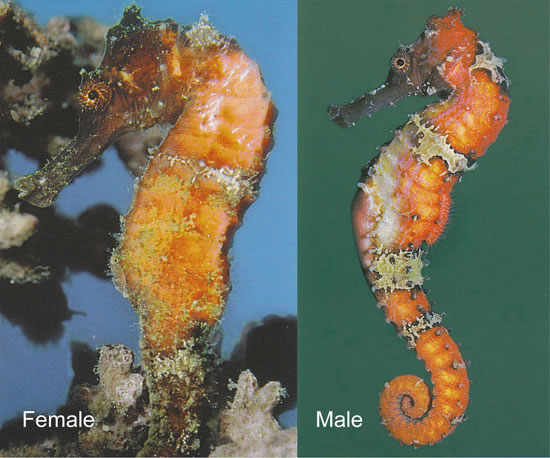- Classification
- ACTINOPTERYGII
- SYNGNATHIFORMES
- SYNGNATHIDAE
- Hippocampus
- spinosissimus
Queensland Seahorse, Hippocampus spinosissimus Weber 1913

A Queensland Seahorse, Hippocampus queenslandicus. Source: Rudie Kuiter / Aquatic Photographics. License: All rights reserved
Like several seahorse species in the West Pacific, adults of the Queensland Seahorse are almost smooth, although juveniles are very spiny.
Queensland Seahorse, Hippocampus spinosissimus Weber 1913
More Info
|
Distribution |
Endemic to tropical waters of north-eastern Australia, from Princess Charlotte Bay to Southport, Queensland; benthic in inner reef waters on rubble substrates and in sponge and seagrass habitats near coral reefs at 20-63 m; often attached to corals in deep current-prone channels between reefs or islands. |
|
Features |
Meristic features: Dorsal fin 16-18 (rarely 16 or 18); Anal fin 4; Pectoral fin 16-19 (rarely 16 or 19); trunk rings 10-11 (rarely 10); tail rings 35-36; subdorsal rings 2 + 1. |
|
Size |
Height to about 125 mm. |
|
Colour |
Colour variable in life, snout yellow-orange to deep red or dark brown, front of head usually darker or dusky; pale grey saddles or bands with dark margins over trunk and tail, one broadly over first 3 trunk rings, a narrower saddle on 7th ring usually reaching ventral ridge, and one or two broad and narrow saddles anteriorly on tail. Deep water specimens usually red or orange, possibly matching colours of corals and sponges at that depth. In preservative - pale to blackish-brown with dusky or grey saddle-like markings. |
|
Feeding |
Carnivores. Like most other seahorses, this species presumably preys on small crustaceans and other planktonic invertebrates. |
|
Biology |
Males brood and nourish the developing embryos before giving birth to tiny independent young. The female uses an ovipositor to transfer her eggs into an elaborate enclosed pouch under the abdomen of the male. The male not only fertilizes the eggs inside the pouch and provides physical protection for the developing embryos, he also osmoregulates and aerates the embryos and may provide some nourishment until the offfspring are born. |
|
Fisheries |
None. Although taken in trawls, there is no known trade in this species for the aquarium or Asian Traditional Medicine industries. |
|
Conservation |
International: Listed under Appendix II of the Convention on the International Trade in Endangered Species of Wild Flora and Fauna (CITES). As a result, the species is subject to the Convention, http://www.cites.org/. |
|
Remarks |
|
|
Similar Species |
Most similar to H. alatus, differs in usually having more elongate and sharper spines. Differs from H. semispinosus in its colour pattern and in having a shorter, less slender snout. |
|
Etymology |
|
|
Species Citation |
Hippocampus spinosissimus Weber, 1913, Fische Siboga: 120. Type locality: Sapeh Strait, Indonesia, Siboga station 49, 70m. |
|
Author |
Dianne J. Bray & Vanessa J. Thompson |
Queensland Seahorse, Hippocampus spinosissimus Weber 1913
References
Hoese, D.F., D.J. Bray, J.R. Paxton & G.R. Allen. 2006. Fishes. In Beesley, P.L. & A. Wells. (eds.) Zoological catalogue of Australia. Volume 35. ABRS & CSIRO Publishing: Australia, 2178 pp. (as Hippocampus queenslandicus)
Horne, M.L. 2001. A new seahorse species (Syngnathidae: Hippocampus) from the Great Barrier Reef. Rec. Aust. Mus. 53: 243-246. (as Hippocampus queenslandicus)
Kuiter, R.H. 2000. Seahorses, Pipefishes and their Relatives. Chorleywood, UK: TMC Publishing, 240 pp. (as Hippocampus sp. 4.)
Kuiter, R.H. 2001. Revision of the Australian Seahorse of the genus Hippocampus (Syngnathiformes: Syngnathidae) with descriptions of nine new species. Rec. Aust. Mus. 53: 293-340. (as Hippocampus queenslandicus)
Paxton, J.R., Hoese, D.F., Allen, G.R. & Hanley, J.E. (eds) 1989. Zoological Catalogue of Australia. Pisces: Petromyzontidae to Carangidae. Canberra : Australian Government Publishing Service Vol. 7 665 pp.
Pogonoski, J.J., D.A. Pollard & J.R. Paxton. 2002. Conservation Overview and Action Plan for Australian Threatened and Potentially Threatened Marine and Estuarine Fishes. Canberra, Environment Australia, 375 pp. (as Hippocampus queenslandicus)
Teske, P.R., Lourie, S.A., Matthee, C.A. & Green, D. 2007. Hippocampus queenslandicus Horne, 2001 — a new seahorse species or yet another synonym? Australian Journal of Zoology 55: 139-145.
Weber, M. 1913. Die Fische der Siboga-Expedition. Sitzungsberichte der Akademie der Wissenschaften in Wien. Mathematisch-Naturwissenschaftliche Klasse 57: 1-710 123 figs 12 pls
Whitley, G.P. 1940. Illustrations of some Australian fishes. The Australian Zoologist 9(4): 397-428 figs 1-45 pls 30-31 (as Hippohystrix spinosissimus)

